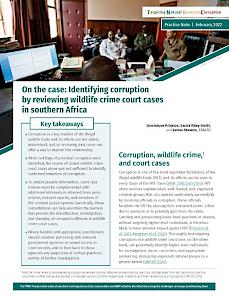How Many Animals Die In The Illegal Animal Trade

Pangolin scales seized by Malaysia Customs. Pangolins are the globe'south most trafficked mammal, a million have been poached in the concluding decade to satisfy Asian demand for their products © TRAFFIC
i
the conservation crunch of our time
Illegal wild fauna trade is devastating wildlife species the world over, as poachers, traffickers and highly-organised criminal syndicates ruthlessly pursue profit at any cost to meet consumer demand.
The trafficking and unsustainable trade in wild fauna bolt such as elephant ivory, rhino horn, pangolin scales, tiger bone, bear bile, and rosewood are causing unprecedented declines in some of the earth'due south almost charismatic, as well as some lesser-known, wildlife species. We're on the frontline working to ensure that illegal wild animals trade is identified, prevented, and prosecuted at every opportunity.
USD7–23 billion
2016 UN estimate of annual value of illegal wild animals trade
our work on illegal wild animals trade
enhancing responses to wild fauna crime and illegal trade
Our work is focused on achieving a sustained reduction in illegal wildlife trade by increasing the risks and reducing the rewards associated with trading in wildlife contraband, thereby reducing the criminal motivation and date in the illicit merchandise that is driving the poaching crisis.
A Sumatran Tiger Panthera Tigris snared to death in Indonesia. Indiscriminately set illegal snares pose a huge run a risk to non merely Big Cats but all manner of wild animals species © WWF-Republic of indonesia / Osmantri
i
We work to tackle wildlife crime and illegal wildlife forth the entire trade chain – from source to destination.
We work with enforcement agencies forth supply chains to ensure they are equipped to detect, place and forestall illegal merchandise. Below are some key actions we take to work towards a sustained reduction in poaching and illicit wildlife merchandise.
international policy

private sector partnerships

trade data and analysis

behavioural change initiatives

a selection of species threatened by illegal merchandise
pangolins
An estimated one million pangolins have been poached in the last decade, making them the near trafficked mammals in the globe.
These shy creatures are poached in Asia and Africa for their scales and body parts, consumed for nourishment, a symbol of wealth or within traditional medicine. We're working to introduce measures to prevent the over-exploitation of these remarkable animals and turn the tide for pangolins.
more most pangolins
Ground pangolin Smutsia temminckii, pangolins are predominantly poached for their scales and meat © Darren Pietersen / African Pangolin Working Group
i
African rhinos
Black and White Rhinos are among Africa's most iconic mega-fauna; gentle grazers and browsers who once spanned the entire continent.
Subsequently years of ruthless poaching by organised criminal syndicates for their keratin horn, both African species of rhino are at present threatened with extinction in the wild and in desperate need of protection. We're working to both reduce demand for their horn among target consumers in Asia, and develop innovative approaches to combating poaching and the illegal merchandise in rhino horn.
more than about African rhinos
An African Black Rhinoceros Diceros bicornis, poached for their horn © Richard Edwards / WWF-United kingdom of great britain and northern ireland
i
African Elephants
African Elephants are arguably the well-nigh well-known species to be heavily impacted by illegal merchandise and wildlife offense, given that approximately 90% have been decimated within the last century.
Global efforts to contrary this devastating onslaught on African Elephant populations accept seen positive results, but demand for ivory still exists and illegal traders remain as resourceful and ruthless as ever. By closing domestic ivory markets which are contributing to poaching we tin can take significant steps towards ending a slaughter that has lasted for decades.
more about african elephants
African Elephant Loxodonta africana, is mostly poached for its tusks © naturepl.com / Tony Heald / WWF
i
tigers
Tiger Panthera tigrispopulations have been devastated by poaching, illegal trade, human-wild animals conflict and habitat loss. Once mutual across Asian range states, these magnificent big cats are now estimated to number approximately 3,800 in the wild.
TRAFFIC monitors the illegal trade in tigers and found that an average of 110 individuals a yr have entered the illegal trade chain in Asia over the last sixteen years. As a result of such findings, Parties to CITES are at present committed to phasing out tiger farming, which contributes to this trade and stimulates demand for their parts. Despite such positive moves, there's withal a long way to go before wild tigers shed their Endangered status.
more most tigers
Seized Tiger skins in Chitwan National Park, Nepal © Marker Atkinson / WWF
i
tropical timber
Timber is the most widely traded wildlife commodity worldwide, a pregnant amount of which is harvested and traded illegally.
Regulating this trade to ensure timber is harvested and traded legally poses meaning challenges. Of particular business organization are the threats facing tropical timbers, such every bit diverse species of Rosewood Dalbergia spp. In some nations, including Madagascar and Cameroon, overexploitation of precious timber is occurring at alarming levels, with woods clearance decimating biodiversity and threatening the livelihoods of local people.
more than about timber trade
Rosewoods, such every bit this from Madagascar, are in loftier demand from markets in Asia © naturepl.com / Nick Garbutt / WWF
i
Abalone
South African AbaloneHaliotis midaeis the about heavily exported species in aquaculture anywhere in the globe. 95% of South African Abalone exports go to Hong Kong, where it is it consumed equally a delicacy or re-exported.
Recent TRAFFIC surveys have revealed that approximately 65% of South Africa'due south abalone exports are harvested illegally, and that organised criminal syndicates and even drug cartels are involved in the illegal trade that is harming both local communities and abalone populations.
more about fisheries
Southward Afriucan Abalone Haliotis midae, consumed in Hong Kong and red china as a effeminateness © Derek Keats
i
news and materials on illegal wild fauna merchandise
Much of our work combating illegal merchandise is aimed at supporting governments and enforcement agencies to notice and prevent it. Explore some recent materials and news below.
Latest reports related to ILLEGAL WILDLIFE Trade
TRAFFIC routinely monitors and analyses illegal trade, so the vast majority of our reports business organisation wild animals offense by proxy. Here are some recent examples specifically relevant to wild fauna offense and poaching.
Visit our resource library for the fullTRAFFICpublication archive.



achieving positive change
A major increase in awareness, political volition, and ultimately action on the basis is needed to assist ensure the future of species and products at risk through mismanagement and unsustainable harvesting.
2017–2020 strategy
Source: https://www.traffic.org/about-us/illegal-wildlife-trade/
Posted by: johnsonhicither.blogspot.com




0 Response to "How Many Animals Die In The Illegal Animal Trade"
Post a Comment